Intel’s Silvermont Architecture Revealed: Getting Serious About Mobile
by Anand Lal Shimpi on May 6, 2013 1:00 PM EST- Posted in
- CPUs
- Intel
- Silvermont
- SoCs
ISA
The original Atom processor enabled support for Merom/Conroe-class x86 instructions, it lacked SSE4 support due to die/power constraints; that was at 45nm, at 22nm there’s room for improvement. Silvermont brings ISA compatibility up to Westmere levels (Intel’s 2010 Core microprocessor architecture). There’s now support for SSE4.1, SSE4.2, POPCNT and AES-NI.
Silvermont is 64-bit capable, although it is up to Intel to enable 64-bit support on various SKUs similar to what we’ve seen with Atom thus far.
IPC and Frequency
The combination of everything Intel is doing on the IPC front give it, according to Intel, roughly the same single threaded performance as ARM’s Cortex A15. We’ve already established that the Cortex A15 is quite good, but here’s where Silvermont has a chance to pull ahead. We already established that Intel’s 22nm process can give it anywhere from a 18 - 37% performance uplift at the same power consumption. IPC scaling gives Silvermont stable footing, but the ability to run at considerably higher frequencies without drawing more power is what puts it over the top.
Intel isn’t talking about frequencies at this point, but I’ve heard numbers around 2 - 2.4GHz thrown around a lot. Compared to the 1.6 - 2GHz range we currently have with Bonnell based silicon, you can see how the performance story gets serious quickly. Intel is talking about a 50% improvement in IPC at the core, combine that with a 30% improvement in frequency without any power impact and you’re now at 83% better performance potentially with no power penalty. There are other advantages at the SoC level that once factored in drive things even further.
Real Turbo Modes & Power Management
Previous Atom based mobile SoCs had a very crude version of Intel’s Turbo Boost. The CPU would expose all of its available P-states to the OS and as it became thermally limited, Intel would clamp the max P-state it would expose to the OS. Everything was OS-driven and previous designs weren’t able to capitalize on unused thermal budget elsewhere in the SoC to drive up frequency in active parts of chip. This lack of flexibility even impacted the SoC at the CPU core level. When running a single threaded app, Medfield/Clover Trail/et al couldn’t take thermal budget freed up by the idle core and use it to drive the frequency of the active core. Previous Atom implementations were basically somewhere in the pre-Nehalem era of thermal/boost management. From what I’ve seen, this is also how a lot of the present day ARM architectures work as well. At best, they vary what operating states they expose to the OS and clamp max frequency depending on thermals. To the best of my knowledge, none of the SoC vendors today actively implement modern big-core-Intel-like frequency management. Silvermont fixes this.
Silvermont, like Nehalem and the architectures that followed, gets its own power control unit that monitors thermals and handles dynamic allocation of power budget to various blocks within the SoC. If I understand this correctly, Silvermont should expose a maximum base frequency to the OS but depending on instruction mix and available TDP it can turbo up beyond that maximum frequency as long as it doesn’t exceed TDP. Like Sandy Bridge, Silvermont will even be able to exceed TDP for a short period of time if the package temperature is low enough to allow it. Finally, Silvermont’s turbo can also work across IP blocks: power budget allocated to the GPU can be transferred to the CPU cores (and vice versa).
By big-core standards (especially compared to Haswell), Silvermont’s turbo isn’t all that impressive but compared to how things are currently handled in the mobile space this should be a huge step forward.
On the power management side, getting in and out of C6 should be a bit quicker. There's also a new C6 mode with cache state retention.


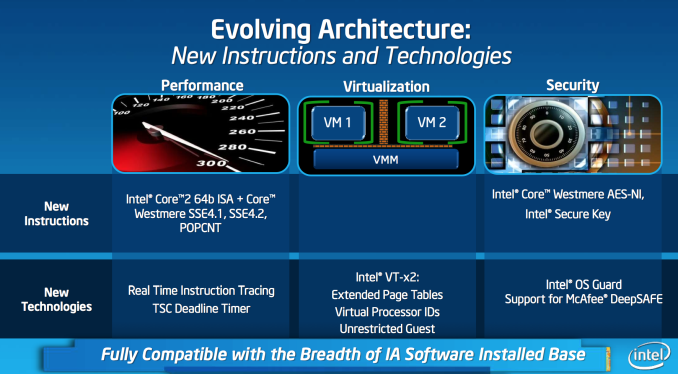
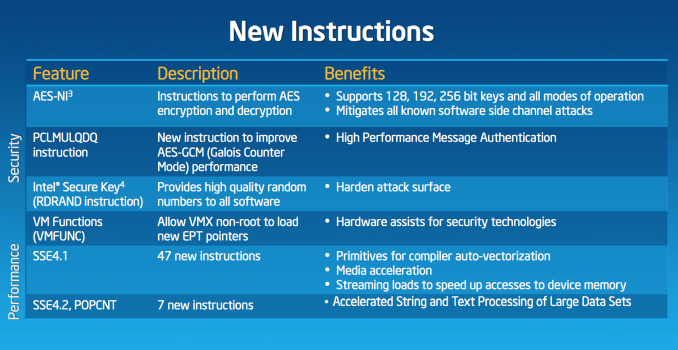
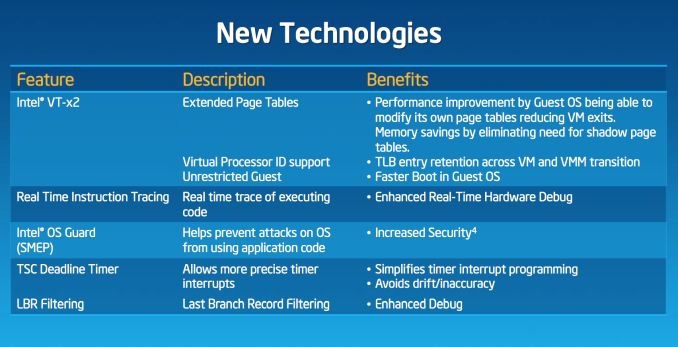
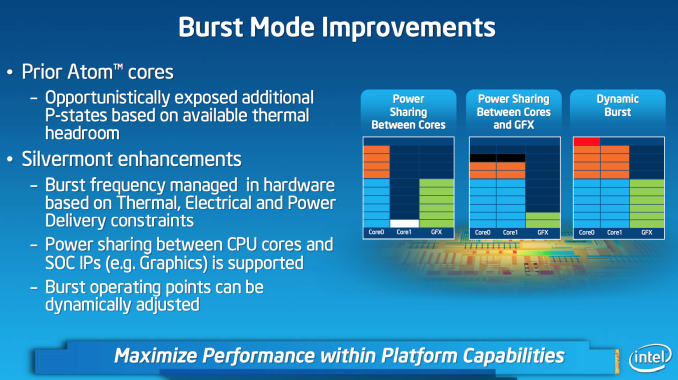
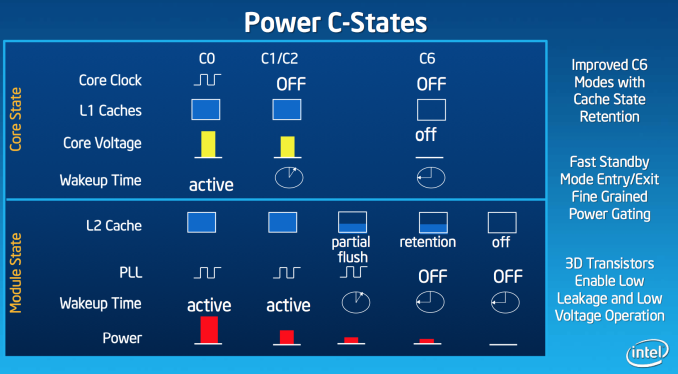








174 Comments
View All Comments
althaz - Monday, May 6, 2013 - link
I don't think you fully grasp the situation. Whilst Intel definitely can (and realistically should) take a strong leadership position in the mobile sector, companies like Qualcomm aren't going anywhere - Intel still won't (be able to?) compete on price, which means even if they take the lions-share of the market, there will be enough left for others to survive (they'll be a lot better off than AMD who sells more-expensive-to-manufacture chips for cheaper that perform worse and use more power).Although I wouldn't be too confident about nVidia, as they are yet to show they can compete with the likes of Qualcomm, let alone Intel.
R0H1T - Tuesday, May 7, 2013 - link
They most certainly will not "take the lions-share of the market" because that belongs to the ultra thin margin chipmakers like Mediatek/Allwinner that deliver quad core ARM v7 based SoC in that 10~20$ range where Intel will not & cannot compete because of their relatively high(er) cost structure !Khato - Tuesday, May 7, 2013 - link
This is an argument that never makes sense to me. Yes, Intel won't go into a market unless the margins make it worthwhile... but do you not realize how cheap it is for Intel to make value processors on a deprecated node? Remember, Allwinner and Mediatek may operate on ultra thin margins, but that's in large part because the majority of the margins on their product go to the foundry they use. aka, when all the high end products are using Airmont cores Intel can keep making use of their 22nm capacity for awhile churning out 'old' Silvermont based products for the value market and simply get closer to the 'operating point' margin for that node.R0H1T - Wednesday, May 8, 2013 - link
I can't say how much TSMC charges for those chips but from what I know the single biggest cost of operations for Intel, outside of their R&D spending & foundry equipment upgrades, must be manpower & the difference between a Chinese/Taiwanese firm vs Intel in this particular dept would be a major one ! This is the real cost advantage that most smaller firms enjoy vis-a-vis Intel & for the foreseeable future they'll continue with this advantage.xTRICKYxx - Tuesday, May 7, 2013 - link
I didn't feel like this article is Intel PR crap. I read it all and I looked at all the improvements that are inbound; and I couldn't help but feel excited about Silvermont just like Anand.I cannot wait to see some benchmarks in the next few months.
Silma - Tuesday, May 7, 2013 - link
On lack of AMD's comparison: there is nothing to compare and while one should tread cautiously with Intel's slides one should not tread at all with AMD's slides because AMD has a huge legacy of promises not held - how many time did we hear it would catch up in notebook or desktops, in performance or performance/watt. While Intel disappoints from time to time (Pentium 4) AMD disappoints most of the time, its last interesting product was the Opteron. Like most companies without vision it ends up doing stupid mergers instead of concentrating on core business.On Intel vs ARM. Silvermont looks promising but Intel needs to accelerate its roadmap. At the end of the year it probably won't compete against a 28nm A15. Qualcomm will not sleep for a year. Also it will have to invest heavily into marketing and OEM incentives if it seriously wants a share of the mobile pile. Will shareholders
ET - Tuesday, May 7, 2013 - link
I'm excited. A 7-8" full Windows tablet with decent performance would be very neat. I'll wait to see what performance this gets in games. I don't need much, just enough to run adventure games and such.R0H1T - Tuesday, May 7, 2013 - link
Then get ready to shell out upwards of 500$ /:pensive69 - Tuesday, May 7, 2013 - link
can't stand getting a partially functioning market focused 'hack' on a cellphone.if the 22nm drill provides a full computer in a smaller form then factor me in!
i don't care which firm does it...like those kids in the commercial
we just want more we want more :).
love it.
Laststop311 - Tuesday, May 7, 2013 - link
this chip will have to pull off a miracle to drive full windows 8 and the everyday apps people use. Seems like it's going to average maybe slightly over 2x performance. That seems like a lot but when you see how poor current atoms are double that performance still is not enough. Does have potential in android phones/tablets and windows 8 phones/tablets as long as it's windows rt on the tablet. Atom still is not good enough for full windows 8